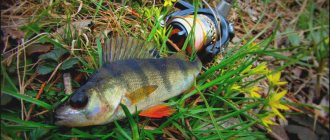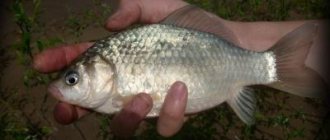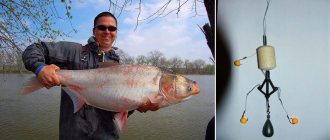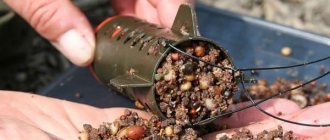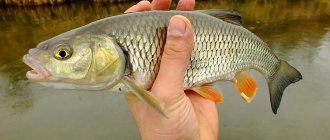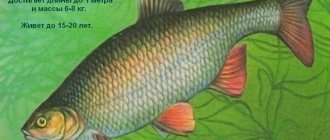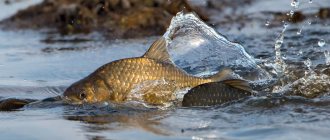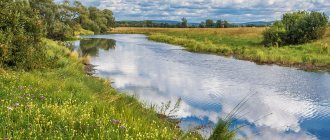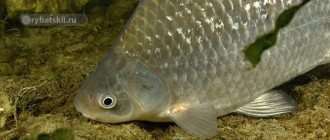At what depths are crucian carp found?
Crucian carp do not live in one place all the time. From time to time they move for the purpose of spawning or searching for food. In winter, crucian carp are not caught. During this period, the fish burrows into the silt and spends the entire time in this state until the onset of warming, when the water temperature reaches +12°C. The depth of immersion of crucian carp into the bottom coating directly depends on the dimensions of the reservoir - the shallower it is, the deeper the fish burrows.
Around March, representatives of cyprinids begin to swim to the surface. During this period, they are inactive, staying in the edges and recesses in which there are remains of plant food. April is considered the opening of the season. At this time, the fish begins to actively feed and is found in bays of shallow depth. In early May, when the water is already warming up, crucian carp swims into small ponds no more than 1 m deep, as well as backwaters with an abundance of reeds and reeds. In the early morning, crucian carp can be found even in the coastal zone.
Important! Crucian carp perfectly captures odors and prefers sharp ones. In this regard, effective flavorings for catching it are garlic, valerian, corvalol, anise and even kerosene.
Spawning occurs from approximately mid-May to the end of June. During this time and the remaining summer months, individuals are found in reed thickets among fallen trees, as well as near the supports of various structures immersed in water. It is worth considering that the depth of fish habitat is greatly influenced by weather conditions. If the weather is cool, the crucian carp swims into the pits and waits there for warming.
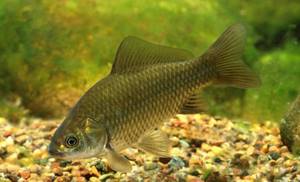
From the beginning of September, the fish begin to gradually move to deeper areas. During this period there is still a bite, but in October - November everything completely depends on the weather. As the water temperature drops to +4°C, this representative of the cyprinids is already beginning to look for a wintering place.
Lures for crucian carp
Crucian carp loves to be capricious not only in the summer, but also in the spring, and I can never confidently guess in advance what exactly this picky fish will bite best today. Even if yesterday he took the worm perfectly, it is not a fact that today in the same place the worm will work again.
There is no point in guessing here, and every fishing trip I calmly and consistently offer the fish different baits that differ in volume, color, taste, and smell. At a minimum, I take maggots, worms, and pearl barley with me. And semolina with two or three flavors; cinnamon and garlic work most reliably. But this is just the starting minimum of bait. Crucian carp can easily demand more. On specific lakes, fish have specific tastes, and you need to know this. And when traveling to unfamiliar bodies of water, I look for important clues from local fishermen who know the priorities of the local fish.
For example, on one lake, where the crucian carp is very confused, only black bread richly flavored with garlic - at one time a local fisherman suggested this cunning bait. It would seem that bread is a bad bait for a feeder, because the dumpling will constantly fly off during casting or pranks of crucian carp, who can remove weakly holding baits from the hook with impunity. So there is no need to roll traditional neat bread dumplings or balls! Bread dough holds perfectly on the hook, if you simply squeeze a piece tightly on the hook with two fingers, forming a shapeless pancake - it does not fly off when casting, and clings to the hook for a long time in the water.
Bait for crucian carp bread with garlic . I usually use the pulp of black bread - “brick”. I chop the garlic very finely (or pass it through a garlic press) and mix thoroughly with the bread pulp. Going overboard with the amount of garlic is problematic, since crucian carp may try to eat only pure garlic, and almost become saturated with it - sometimes you gut the catch, and the fish smells of garlic throughout the kitchen.
Features of catching crucian carp at depth
Summer is the most productive period for fishing. But during spawning, it bites poorly because it loses its appetite and spends energy on reproduction. But after it she becomes hungry and, therefore, quite actively grabs a wide variety of bait (both plant and animal origin in the form of a worm, bloodworms). The fisherman’s only task during this period is to figure out how to fish out prey from the water thickets without tangling the gear.
Find out also how to catch crucian carp in windy weather.
From what depth does crucian carp bite?
In the summer, representatives of cyprinids can be found almost everywhere. Most often, it creates sites in reed thickets. It is there that there is a lot of plant food and various insects. The approximate depth in such areas is from 1 to 2 m. More often, fish bite from the bottom. But it can also rise to the middle layer of water. If there are cold springs at the bottom, then individuals stay in warm streams.
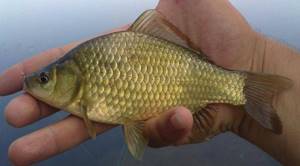
The biggest difficulty when fishing from reeds is precisely the large number of thickets. To make the task easier, you should first cut off the branches, leaving stubble up to 15 cm high sticking out above the water. Then in the evening you need to feed the fish. The next day you can safely go “hunting”.
Important! At night, you should go for crucian carp only in extreme heat, since during the daytime it mainly hides in shady areas and is not at all hungry. The rest of the time, the most successful bite is observed in the morning, subsides at noon, and resumes in the evening and subsides again by nightfall.
The relationship between the depth of the reservoir and fishing efficiency:
- within 1-2 m - medium and small specimens will bite well here in the morning;
- depth 2-3 m - areas are usually located at a distance of 5-20 m from the coastline, will be catchable in the middle of the day;
- within 4 m or more is an unpromising zone in which the pressure is high and the water itself is not at a comfortable temperature for crucian carp.
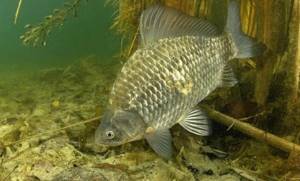
Fishing for crucian carp in the upper layers of water
In the summer, as well as at the very beginning of spring, crucian carp can be found almost at the very surface. What forces bottom fish to change their usual habitat? The following reasons can be identified:
- more favorable oxygen regime;
- changes in atmospheric pressure (its increase);
- more comfortable temperature conditions;
- the presence of food in the form of insects and their larvae that have fallen into the water;
- great competition in the form of other bottom fish (tench, sleeper, carp, carp, etc.)
- unsuitable bottom condition (algae, lack of silt, etc.).
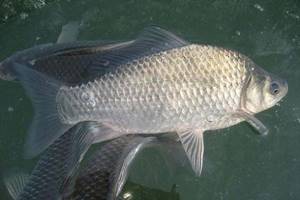
Often in summer crucian carp is as close to the surface of the water as possible
In the upper layers of water, crucian carp often feed in small, low-flow (or closed) reservoirs, where the maximum depth does not exceed 2.5-3 meters. Fish have a need for food, but it is impossible to look for it at the bottom due to insufficient oxygen.
On medium and large lakes, crucian carp are forced to move closer to the surface by the desire to warm up (especially in the spring or after a prolonged cold spell). Another reason is that insects often get into the water, which are a real delicacy for fish. They do not drown, float on the surface and actively move, attracting her.
Therefore, if you notice a couple of crucian carp swimming close to the float, and fishing from the bottom and in mid-water for some time is unsuccessful, then we recommend trying to set the depth to 10-15 cm. The main thing is to use small hooks and a float with a short keel so as not to create false bites when the fish, wandering in the near-surface layer, touches it.
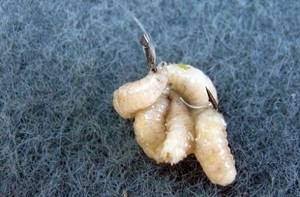
For catching crucian carp in the upper layers of water, bait with maggots is suitable
When fishing for crucian carp in the upper layers of water, you need to pay special attention to the bait.
When a fish takes the bait from the bottom, it savors it for a long time and gradually sucks it in. But near the surface it will not have this opportunity, so the nozzle must be compact and miniature. For example, several maggots, a caddis larva, a small grasshopper or a couple of bloodworms. In this case, catching with dough or a long worm is not rational.
Catching crucian carp with a float rod in summer
If you plan to fish from the shore, then it is best to take a fly rod with a short length: 2-3 m will be enough. A worm or bloodworm is suitable as bait. You can also use different beetles. When they submerge in the water, they create vibrations that attract the fish in question.
Did you know? In New Guinea, spider webs are used to make durable fishing gear.
After immersing the gear in the water, you must wait. You should be careful when fishing. When you see the first bites, you should not immediately hook. You need to wait until the fish begins to lead slightly and pull the tackle along with it. And this time you should be on alert and not make a sharp hook. The prey should be removed carefully so as not to tear its lip.
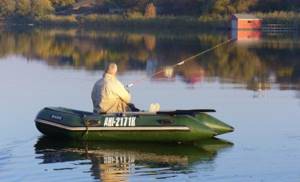
If you plan to fish from a boat, then it is better to set the depth within 1.5 m. As a means of transportation on the water, you should give preference to non-motorized boats - they create less noise.
To know where crucian carp will be caught, you need to study in more detail its habitats in different seasons. This fish prefers reservoirs where there is a muddy bottom and thickets of reeds, as well as other vegetation. It is in them, at shallow depths, that one should most often look for prey.
Which bottom does crucian carp prefer?
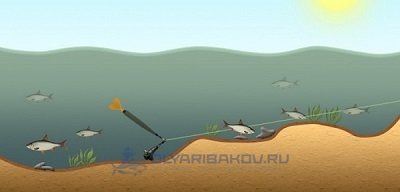
- For the inhabitants of reservoirs, the disadvantage is that in such places there is quite a bit of oxygen - much less than on a sandy or rocky bottom. But for crucian carp this does not matter much. This fish is not at all picky about the oxygen content in the water.
- The second disadvantage of fishing on a silty bottom, which is important only for the fisherman, is that equipment with bait can easily “drown” in it, becoming inaccessible to fish. But it’s not difficult to avoid this, you just need to use the right installations.
Thus, it is in silted areas that you should look for crucian carp in the first place. Fishing here brings the best results.
Crucian carp fishing often takes place on a sandy bottom. This fish also chooses such areas quite willingly. But in terms of attractiveness for crucian carp, the sandy bottom is inferior to the muddy bottom. But it’s easier to catch here. The hook with bait is guaranteed not to go into the ground, regardless of what equipment is used.
You can rarely find crucian carp on a rocky bottom. Here this fish is a rare guest and does not stay long. It is not purposefully caught in rocky areas.
This video talks about where to look for crucian carp in the river, the characteristics of its habitats and migration cycles:
We fish from the bottom or in mid-water
In the fishing community, it is customary to distinguish 5 types of equipment release:
- the bait is at the very bottom;
- at some distance from the bottom (from 1-2 to 10 cm);
- in the water column (somewhere in the middle between the surface and the bottom);
- almost at the surface of the water;
- directly on its surface.
More often than not, all anglers prefer to catch crucian carp with the maximum length of the tackle. Thus, no matter what the load, the nozzle is at the very bottom. This is quite logical, because crucian carp is a bottom-dwelling fish and mainly looks for food in silt deposits. But there are also cases when it does not feed from the bottom.
Let’s say that in a deep layer of silt the bait is often “lost.” The fish does not see it, and the number of bites decreases sharply. However, as soon as you lower the float a few cm, the bite noticeably improves. The fact is that the bait no longer sinks into the silt, but is located above it, attracting crucian carp. It is effective to position the equipment above the bottom (1-2 cm) even when the bait can merge with it. Let’s say that in dark mud it is difficult for a fish to notice a hook with a worm and bloodworms, but in clay and sand – with the same maggot.
Not all fishermen know that it is possible to catch crucian carp even in mid-water. However, this practice in the summer gives good results.
Of course, in the morning and evening it mostly bites from the bottom, but if during the day the air temperature exceeds 30°C, then the fish often moves into the water column. Then you can successfully catch crucian carp with the equipment released only 30-50 cm. However, this is not possible in all reservoirs. Quite often, in hot weather, fish go to distant dumps and deep holes, where they can only be caught using a feeder.
Feeder fishing
All the details of crucian carp fishing on a feeder can be found in our guide.
At the beginning of spring, when the water has just warmed up, like no other gear, a feeder is suitable for catching crucian carp. Since crucian carp do not like currents, most likely you will fish on a lake or pond. Although on the same Volga crucian carp is active in the spring.
For ponds, choose a short feeder rod with a length of 3-3.3 m. Of course, it’s okay if you have 3.9 m, it’s just heavier, and the result in the form of a catch will be the same, only you’ll spend more effort on casting. But for a large river, 3.9 m is the minimum.
reel with friction brake. Rear or front does not matter. No Bayrunner needed. Even a very light reel will do, for example, the budget Daiwa Megaforce X 2500 is an excellent option. For fishing on a large river, the conditions are a little harsh. Choose a larger reel, for example, Daiwa Black Widow - also a very conservative budget, but at the same time, very high-quality option. You can learn about other feeder reels from our rating of Daiwa reels.
Monofilament line 0.2-0.25 mm. For example, Salmo Feederist.
Use a fluorocarbon leash of the same diameter in the rig. It is invisible in the water and does not scare fish.
For bait, you need purchased feeder compositions and mixtures that very actively emit a sweet aroma; you can also make bait yourself (more details at the end of the article).
The best crucian carp rigs:
- paternoster loop;
- symmetrical and asymmetrical loop;
- helicopter and two knots - when fishing in the current;
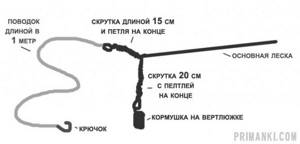
All of these rigs are very sensitive and are ways to spot cautious bites. A helicopter and two knots allow you to fish with baits suspended in the water column under the force of the current. Do not forget that crucian carp is a cautious fish, so it is better to mount the hook on a leash of 70 cm, so as not to scare it, and after feeding, abandon the feeder and switch to a sinker.
Your bait must consist of small parts (fraction particles). This way you can lure fish from a long distance if there is at least a slight current. And also reduce the likelihood of overfeeding the fish.
Subtleties of fishing
Winter fishing is, first of all, about miniature fishing rods with delicate fishing line. To catch crucian carp, stationary fishing rods with a float mount are used. The fundamental difference in the equipment is the use of small lead or tungsten jigs. It is not known why, but fish are caught on a hook less often than on a shipped analogue. You need to set up the gear at home. The alarm should slowly sink under the weight of the jig, but not fall like a stone to the bottom. Correct adjustment allows you to notice the most careful bites. There is also no need to rush with hooking. Often the crucian carp puts out a float, and it must be given time to swallow the bait. Since fishing is carried out at depths of 0.5 to 2 meters, the smallest jigs are used as bait. The best choice would be a tungsten drop or pellet.
The nozzle must lie on the bottom, otherwise the number of bites will decrease several times. In winter, crucian carp are caught both with bloodworms and with plant bait (dough, semolina mash, mastyrka).
Read: Requirements for winter bait
In the cold season, it is important not to overdo it with the bait mixture. Feed bloodworms, as well as loose soil or black dye, must be added to the bait. The crucian carp avoids light spots of food lying on the bottom. In shallow waters, fish are even more cautious, so you need to be quiet on ice.
How to catch crucian carp with a spring?
An article about the features of catching crucian carp with a spring can be read here.
This type of crucian carp fishing has proven itself to be rather wait-and-see, but brings success over a long distance. The method is not sporty and we recommend turning your attention to the feeder (a beginner's guide to equipping the feeder).
In order to make the tackle you will need one spring, 5 cm high and 1.5-2 cm wide.
We attach the spring to the main line, put a wide cambric on the main line and install leashes with hooks. The gear is described in more detail here.
For bait, it is better to use the following mixture: wet the white bread crumb a little and knead until you obtain a plasticine-like consistency. Add grated sunflower seeds to the resulting mixture.
If the current in the place where you are fishing is strong, then the bait should be made more rigid, but if you are fishing in a pond or on a lake, then it is better to use soft bait. Dip the hook spring into the weed before casting to give it a more natural look.
As the water erodes the bait, a cloud of delicious turbidity will form in the water, and the hooks will end up in the water. The crucian carp will eat the bait, and then stumble upon the hook and be hooked.
In cases where fishing takes place in reservoirs with stagnant water, it is very likely that the crucian carp will not be able to smell the smell of complementary food due to the lack of current. Then all kinds of flavors and scent enhancers will come to your aid. But be careful: too strong a smell can scare away fish in cold water. Also spend more time searching for crucian carp trails. Look at the places on the surface of the water where bubbles rise, check the places near the reeds.
Character of the reservoir
Usually crucian carp do not like currents. In summer it is rarely found in rivers with currents. The exception is abnormally hot weather, accompanied by “blooming” water.
In summer, crucian carp go out into the current only in the heat of the moment, when the oxygen content in standing water decreases. The exit of crucian carp into the river is always clearly visible, especially on a hot day. A quite large flock can stand in the water column, but it only goes out into the river not to eat, but to breathe. You can offer crucian carp any bait, at any depth, with the most minimal results.
Under normal conditions, crucian carp prefers to feed in summer in reservoirs with standing water or in river bays. If the depth of the reservoir at the fishing site does not exceed 2 meters, then most likely the crucian carp will have to be caught from the bottom (taking into account the nature of the bottom).
If there are cold springs at the bottom of a reservoir, then the water column is not heated by the Sun to the very bottom. In such cases, the crucian carp will stand either on the boundary of the layers or in the warm layer. It is difficult to determine the fishing depth in such cases. You can go the experimental route and get into the water yourself. You can use an echo sounder or a video rod. You can simply change the depth of the tackle until the crucian carp is found.
In a deep reservoir, in which the layer of silt is quite thick and where food competitors of crucian carp, such as carp or tench, live, sometimes crucian carp does not wait for food at the bottom, but actively catches it at the surface. The depth should be set to no more than 10 cm and the bait should be pulled out evenly and slowly near potential crucian carp shelters, such as islands of algae floating to the surface, or flooded trees.
